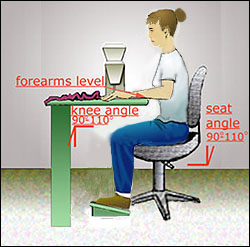“No pain, no gain” may be a great mantra when you’re grinding away on the elliptical or juggling kettle bells, but when it comes to quilting, that’s just so wrong. Quilting is supposed to be fun, people. No. Room. For. Pain.
So, because October is National Ergonomics Month, we’ve gathered a little expert ergo-wisdom to help you stitch happily and healthily. After all, quilting and stitching isn’t like wearing a bikini, which usually only works for about 15 minutes in high school. If we love working with cloth, it’s a forever thing, and we want to do it until they pry the rotary cutter out of our cold, dead hands.
As physical activities go, quilters, sewists and crafters are unlikely to work up a sweat (unless you just chewed up your last piece of custom-dyed silk blend and still have a whole block to go). But these activities are still packed with chances for repetitive motion injuries and muscle strain, even though we’re largely just sitting on our butts. (And no wisecracks about that walk to the ironing board constituting exercise.)
Think, for a minute, about your typical piecing position: head bent forward, spine slightly flexed, hands poised near the needle plate, foot partially flexed over the foot pedal. Now think about holding that position for hours. Ow.
Injuries can also happen at the cutting table, at the ironing board, when we’re working in poor light, when we’re doing handwork, when we’re free-motion quilting, sewing on six million buttons…. You get the picture.
Add in the fact that when many of us finally find time to sew, we want to get the most done possible, so we’re likely to grit our teeth and sew through low-level pain. Bad move, say the docs. If you are feeling any degree of muscle pain from a repetitive action, then muscle injury is occurring already.
Our main goal should be to keep our bodies in neutral as much as possible, says professional quilting organizer, engineer and author Lois J. Hallock. In her book, Creating Your Perfect Quilting Space (Martingale, 2005), Lois writes about the ergonomics of a sewing space being a critical part of its efficiency, as well as key to a stitcher’s comfort. Being “in neutral,” she says, means as little joint flexing as possible, being relaxed, and sitting or standing with weight centered. It means not having to lean or strain in any way as you cut and sew.
But every body is different and last we heard, IKEA wasn’t making custom-fit furniture, so accommodations must be made. Let’s take a look at the key areas where table height equals comfort.
The Cutting Table
This is the Number One area where we hurt ourselves–by cutting for hours on a table that is the wrong height. Too low, and you’re over-curving your spine. Too high, and your elbow flexes uncomfortably, making it hard to get an even stroke. (And it’s hard to see where you’re cutting, so you’ve added even more potential for injury.) You need a table that matches your height and body frame.
In her book, Organizing Solutions For Every Quilter (C & T Publishing, 2011), Carolyn Woods gives these simple instructions for figuring out how high your cutting table should be: “Your cutting surface should be quite a bit higher than your sewing table. To determine the best height for you, stand with your feet flat on the floor and your arms straight forward and bent 90 degrees at the elbow. Your forearms should lie flat on the cutting table. This height is likely to be between 36˝ and 40˝ (91–102cm).”
If you’ve got big bucks to drop on specialty sewing room furniture with hydraulic lifts, this is no problem. The rest of us, well, we just get creative. We’ve heard of quilters using old paint cans, PVC pipe or plastic bed risers to give their tables a boost.
And don’t forget to use this same formula on your ironing board, if you use a stand-up type. At least this is easily adjusted, and your lower back will be delighted when you’re busily pressing those gazillion HSTs for that Flying Geese border.
The Sewing Table
The sewing table might be a little more difficult, given that many of us may have pre-constructed cabinets that came with our machine, or use portable machines. The key here, says Lois, is to make sure the sewing table is about 9 inches above the seat of your chair.
“Your seat needs to be adjusted so that when your arms and shoulders are relaxed, your palms can rest on the sewing machine bed with your elbows forming a 90 degree angle,” she writes in her book.
And you need enough legroom under your sewing table to be able to sit comfortably with your body at the centerline of the needle, she says. If you have to crunch up your legs and lean to one side to get a good needle’s eye view, the table is wrong, wrong, wrong.
Many upline sewing tables are constructed so that a sewing machine fits snugly into the tabletop, supported from below by heavy duty brackets that hold the needle plate and sewing arm flush with the countertop surface. Now that’s some smooth, fun sewing! If you’re on more of a budget, bribe a shop-savvy friend or spouse into rigging this up for you. (And if you can wield a jigsaw as well as a Janome, well, girl, you’re our hero!)
Here’s author Carolyn Woods’ formula for identifying your ideal sewing table height: “To know the ideal heights for you, begin by sitting in your sewing chair. Be sure that your chair is set at a height so that your feet are flat on the floor. With your arms at your sides and elbows bent so that your forearms are at 90 degree from your upper arms, measure from your elbow to the floor. Add 51/2˝–7˝ to that measurement to calculate the final sewing table height, which is usually between 28˝ and 36˝ (71–91cm).”
And here’s our suggestion: Get a sew-buddy to come over and help you measure your true body angles when you assume the sewing and cutting positions. Then, do the same in return for your pal.
Oh, Q-Bies, here’s so much more to tell you about safe stitching! Next week we’ll show off some excellent ergonomic equipment and quilting tools on the market to help us all. And then the week after, we’ll look at exercises and stretches you can do to help alleviate the pain.
(Editor’s Note: Special thanks to Stephanie Thompson, M.D., of Kansas City, Missouri, who provided background research.)










COMMENT #1
Amen on ergonomics. I put my cutting table on bed risers and it was just the perfect height. Now I can cut and cut and cut!
COMMENT #2
Oooh, thisd was very helpful (especially since I’ m currently laying the floor for my re-designed sewing room. [No more carpet! Laminate flooring purchased at a Habitat re-store for less than 1/2 the price of lineoleum flooring at a big box store! Hurray for Habitat Re-store helping me= helping them= helping others. win/win/win! I digress. lol)
Anyway! This is great to know and I will look forward with baited breath to your articles in the series. I’m at the point where I need weekly massages because of the time I spend in my sewing room. If I cut out that expense, I’ll have more money for fabric! :p
COMMENT #3
I was here!
COMMENT #
Thank you Jacquie! How’s that lovely kitty book doing?
COMMENT #4
some great information here, could be useful for many different applications.
COMMENT #5
One of our former guild members gave a talk on ergonomics several years ago – it’s nice to have a refresher course!
COMMENT #6
Very good article. I got an office chair that can vary in height, which is great for me. I’m short, so getting a chair that fits is difficult. Nothing is built for a short person, so I am looking forward to future suggestions on adjustments.
COMMENT #7
Thanks for the great article! I am linking up from my Blog. Everyone should hear this.
COMMENT #8
I appreciate the article but… when figuring the height of your work surface you should take into consideration the tool you will be using (rotary cutter, iron etc.) your elbow should be a 90 degrees to the floor AND your wrist should be in a neutral position therefore the height of the table should be less than the distance between the floor and your forearms in that 90 degree position to accommodate the tool size. (typically cutting table should be slightly higher than the ironing surface )
COMMENT #9
Meh, I married a massuese 😛
COMMENT #10
Great article! I have been having some pain when I sew since I started my new job and the advice will be helpful.